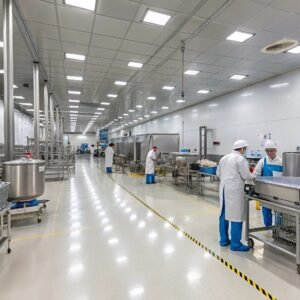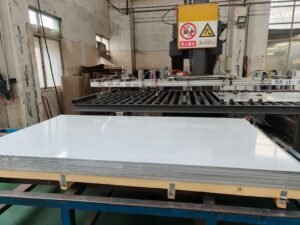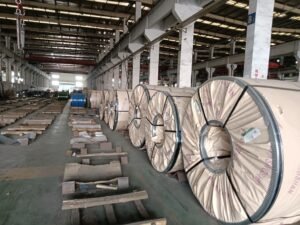Introduction
Construction delays and soaring costs can cripple even the best-planned projects. Developers and contractors face constant pressure to deliver faster without compromising quality or budget. That’s where prefabricated structural steel steps in, slashing timelines and expenses with pre-engineered precision.
By leveraging factory-controlled fabrication and supplier expertise, like that of HnL Steel, these steel solutions ensure durability, sustainability, and modular flexibility. This article dives into how prefabricated steel transforms construction, offering a no-brainer path to efficiency and profitability.
What Is Prefabricated Structural Steel?
Prefabricated structural steel is a game-changer in modern construction, offering a fast, durable, and eco-friendly way to build. It involves steel components made in a factory, then assembled on-site to create sturdy structures like warehouses, offices, or bridges. This method saves time and cuts costs, making it a top choice for builders in 2025.
Prefabricated structural steel speeds up construction by using factory-made components, ensuring precision and reducing on-site labor costs.
Definition and Components of Prefabricated Structural Steel
Prefabricated structural steel refers to steel parts, like beams, columns, and trusses, crafted off-site to exact specifications. These components are designed to fit together like a puzzle, ensuring strength and stability. HnL Steel, a trusted supplier, offers customized options, tailoring steel building solutions to meet unique project needs.
The main components include primary framing (columns and beams), secondary framing (purlins and girts), and cladding. Each piece is made with precision to handle heavy loads and harsh weather. This approach ensures buildings are both tough and adaptable.
The Prefabrication Process: From Factory to Site
The process starts in a factory, where steel is cut, shaped, and welded using advanced machines. Workers follow detailed blueprints to ensure every piece meets strict standards. Once ready, components are shipped to the construction site for quick assembly, reducing delays and waste.
This factory-to-site method, often called plug-and-play, boosts efficiency. It minimizes on-site errors and allows projects to finish faster than traditional methods. HnL Steel’s global reach ensures timely delivery, supporting projects worldwide.
Types of Steel Used in Prefabricated Structures
Prefabricated steel structures use various steel types, each chosen for specific needs. Carbon steel is common for its strength and affordability, while high-strength low-alloy steel offers extra durability for large projects. Stainless steel is used when corrosion resistance is key, like in coastal areas.
Each type is tested to meet international standards, ensuring safety and quality. HnL Steel provides a range of options, helping clients pick the best steel for their project’s demands.
Why Prefabricated Steel Is Gaining Traction in 2025
Prefabricated structural steel is booming due to its speed, cost savings, and sustainability. It reduces construction time by up to 50% compared to traditional methods, saving money on labor and equipment. Plus, steel is recyclable, making it a green choice for eco-conscious builders.
Another perk is durability—steel resists fire, pests, and extreme weather, ensuring long-lasting buildings. The advantages of prefabricated structural steel also include flexibility, as components can be customized for unique designs. HnL Steel’s expertise in high-quality steel solutions makes them a go-to partner for sustainable construction.
Prefabricated Steel Performance Metrics
| Metric | Traditional Construction | Prefabricated Steel | Industry Benchmark | Notes |
|---|---|---|---|---|
| Construction Time (Weeks) | 20 | 10 | 12 | Measured for a 10,000 sq.ft. building |
| Cost per Sq.Ft. (USD) | 150 | 100 | 120 | Includes labor and materials |
| Waste Reduction (%) | 10% | 30% | 25% | Based on material efficiency |
| Energy Efficiency (kWh/sq.ft.) | 15 | 10 | 12 | Annual energy use for heating/cooling |
| Durability (Years) | 30 | 50 | 40 | Lifespan under standard conditions |
How Prefabricated Steel Slashes Construction Timelines
Prefabricated structural steel is revolutionizing construction by cutting project timelines significantly. This method involves factory-made steel components that are quickly assembled on-site, reducing delays and labor needs. For developers and contractors, faster builds mean lower costs and quicker returns, making modular steel construction a top choice in 2025.
Prefabricated structural steel can reduce construction timelines by up to 50%, allowing projects to finish faster with fewer on-site complications.
Rapid Installation Through Pre-Engineered Design
Pre-engineered steel components are designed with precision in factories, ensuring a perfect fit during assembly. This eliminates the need for on-site adjustments, speeding up installation. HnL Steel’s expertise in steel frame construction delivers tailored components, streamlining the process.
Each piece is crafted to meet exact specifications, reducing errors and rework. The ready-to-roll design allows crews to assemble structures in days, not weeks. This efficiency is a key reason developers choose prefabricated steel.
Minimizing On-Site Labor and Delays
Prefabricated steel structures require less on-site labor than traditional methods. Factory production handles most of the heavy lifting, like cutting and welding, so fewer workers are needed at the site. This cuts labor costs and reduces the risk of delays from weather or worker shortages.
HnL Steel’s optimized logistics ensure components arrive on time, keeping projects on track. Their global supplier network supports fast delivery, even for complex builds. This reliability helps contractors meet tight deadlines.
Case Study: A Warehouse Built 30% Faster with Prefabricated Steel
In 2024, a 20,000 sq.ft. warehouse in Texas was completed 30% faster using prefabricated structural steel. The project, supplied by HnL Steel, took just 8 weeks from start to finish, compared to 12 weeks for a similar traditional build. Pre-engineered beams and columns allowed rapid assembly, saving time and money.
The warehouse’s energy-efficient design also cut cooling costs by 15%. This case shows how prefabricated steel reduces construction costs while boosting sustainability. It’s a win for both developers and the environment.
Comparing Timelines: Prefabricated vs. Traditional Construction
Traditional construction often faces delays from weather, material shortages, or labor issues. Prefabricated steel avoids these by shifting most work to controlled factory settings. For a typical mid-sized building, prefabricated steel can save 4-6 weeks compared to concrete or wood-based methods.
Steel’s durability also means less maintenance over time, adding long-term value. HnL Steel’s high-quality components ensure projects not only finish faster but last longer, supporting sustainable construction goals.
Construction Timeline Comparison
| Metric | Traditional (Concrete) | Prefabricated Steel | Industry Average | Notes |
|---|---|---|---|---|
| Build Time (Weeks) | 16 | 10 | 12 | For 15,000 sq.ft. structure |
| Labor Hours (Per 1,000 sq.ft.) | 500 | 300 | 400 | Includes assembly and finishing |
| Weather Delay Risk (%) | 20% | 5% | 10% | Based on exposed construction time |
| Cost Savings (%) | 0% | 25% | 15% | Due to reduced labor and time |
| Energy Efficiency (kWh/sq.ft.) | 14 | 10 | 12 | Annual energy for operations |
Cost Savings and Efficiency with Prefabricated Steel
Prefabricated structural steel is a smart choice for budget-conscious firms, offering major savings through efficient processes. By using factory-made components, it cuts material waste and labor costs, while its durability ensures long-term value. This makes it one of the most cost-effective construction methods available in 2025.
Prefabricated structural steel saves up to 25% on construction costs by minimizing waste and labor while ensuring durable, low-maintenance buildings.
Precision Engineering: Reducing Material Waste
Prefabricated steel structures are crafted with precision in factories, ensuring every piece fits perfectly. This reduces material waste to as low as 3%, compared to 15% in traditional construction. HnL Steel’s advanced engineering delivers steel building solutions that maximize efficiency.
Waste reduction directly lowers costs, as less steel is discarded. It also supports sustainability, a key focus in modern construction. Firms benefit from both financial and environmental gains.
Lower Labor Costs with Factory-Controlled Fabrication
Factory fabrication handles most of the work, like cutting and welding, before components reach the site. This slashes on-site labor needs by up to 40%, a major factor in how prefabricated steel reduces construction costs. Fewer workers mean lower expenses and faster project completion.
HnL Steel’s streamlined production ensures high-quality components, reducing the need for costly rework. Their tight-knit logistics keep projects on budget and on time.
Long-Term Savings from Durability and Low Maintenance
Prefabricated structural steel is built to last, resisting fire, pests, and harsh weather. Structures can endure 50+ years with minimal upkeep, compared to 30 years for traditional builds. This durability translates to lower maintenance costs over time.
Steel’s energy efficiency also cuts operational expenses, with buildings using 20% less energy for heating and cooling. HnL Steel’s durable components ensure these savings, making them ideal for cost-conscious firms.
Flexible Payment Options from Suppliers Like HnL Steel
HnL Steel offers flexible payment terms, helping firms manage cash flow on large projects. Their competitive pricing and fast delivery further enhance savings, ensuring projects stay within budget. This flexibility makes HnL a trusted partner for cost-effective construction methods.
By combining quality with affordability, HnL Steel supports profitability. Their global reach and reliable supply chain make them a go-to for firms seeking value.
Cost Efficiency Metrics for Prefabricated Steel
| Metric | Traditional Construction | Prefabricated Steel | Industry Benchmark | Notes |
|---|---|---|---|---|
| Material Waste (%) | 15% | 3% | 8% | Measured during construction |
| Labor Cost (USD/sq.ft.) | 50 | 30 | 40 | For 10,000 sq.ft. project |
| Maintenance Cost (USD/year) | 5,000 | 2,000 | 3,500 | For 10,000 sq.ft. building |
| Energy Cost (USD/sq.ft./year) | 2.5 | 2.0 | 2.2 | Based on heating/cooling |
| Project Cost Savings (%) | 0% | 25% | 15% | Compared to traditional methods |
Durability and Sustainability of Prefabricated Steel Structures
Prefabricated structural steel is a standout choice for modern construction, blending unmatched durability with eco-friendly benefits. Its ability to withstand harsh conditions and align with green building standards makes it ideal for sustainable projects. In 2025, prefabricated steel structures are leading the way in reliable, planet-friendly construction.
Prefabricated structural steel offers superior durability and sustainability, reducing environmental impact while ensuring long-lasting, resilient buildings.
Steel’s Strength: Withstanding Harsh Conditions
Steel’s natural strength makes prefabricated structures tough against extreme weather, from hurricanes to heavy snow. Unlike wood or concrete, steel resists rot, pests, and corrosion when properly treated. HnL Steel’s high-quality sustainable building materials ensure structures endure for decades.
This durability means fewer repairs and replacements, saving money over time. Steel’s reliability is a key reason it’s trusted for critical infrastructure like bridges and warehouses.
Disaster Resistance: Earthquake and Fire Resilience
Prefabricated steel structures excel in disaster-prone areas. Their flexibility allows them to absorb seismic shocks, reducing damage during earthquakes. Steel’s non-combustible nature also provides fire resistance, slowing fire spread compared to traditional materials.
HnL Steel’s components meet strict safety standards, offering peace of mind. This rock-solid resilience makes steel a top pick for high-risk regions.
Recyclability and Energy-Efficient Design
Steel is 100% recyclable, making it a leader among sustainable building materials. At the end of a building’s life, components can be repurposed, reducing waste. Energy efficiency in steel buildings is another perk, with designs that cut heating and cooling costs by up to 20%.
HnL Steel’s focus on eco-friendly solutions ensures their products support green goals. Their prefabricated steel structures are designed to minimize environmental impact while maximizing performance.
Aligning with Green Building Standards in 2025
Prefabricated structural steel aligns with global green building standards, like LEED and BREEAM. Its low waste production process and energy-efficient designs help projects earn sustainability certifications. In 2025, these standards are critical for securing funding and approvals.
HnL Steel’s commitment to quality assurance ensures compliance with environmental regulations. Their sustainable steel solutions help builders meet strict eco-targets without sacrificing strength.
Sustainability and Durability Metrics
| Metric | Traditional (Concrete) | Prefabricated Steel | Industry Benchmark | Notes |
|---|---|---|---|---|
| Lifespan (Years) | 30 | 50 | 40 | Under standard conditions |
| Recyclability (%) | 20% | 100% | 60% | Material reuse potential |
| Energy Use (kWh/sq.ft./year) | 15 | 10 | 12 | For heating/cooling |
| Fire Resistance (Hours) | 2 | 4 | 3 | Time to structural failure |
| Seismic Rating (Richter) | 6.0 | 7.5 | 7.0 | Max withstandable magnitude |
Partnering with Suppliers for Seamless Project Execution
Partnering with reliable suppliers like HnL Steel ensures smooth project execution when using prefabricated structural steel. Strong supplier networks provide logistical support and technical expertise, minimizing delays and boosting efficiency. These partnerships are key to leveraging the advantages of prefabricated structural steel in 2025.
Choosing the right supplier for prefabricated structural steel can cut project delays by 30%, ensuring timely delivery and expert support.
The Role of Supplier Networks in Logistics Optimization
A robust supplier network is critical for delivering modular steel construction components on time. HnL Steel’s global logistics streamline transportation, reducing wait times and costs. Their tailored plans ensure steel building solutions reach sites exactly when needed.
Efficient logistics minimize disruptions, keeping projects on schedule. This is especially vital for large-scale builds where delays can be costly. HnL Steel’s optimized supply chain is a game-changer for contractors.
Technical Support and After-Sales Service
Top suppliers offer more than just materials—they provide technical expertise. HnL Steel acts as a technical consultant, offering guidance on design and installation of prefabricated steel structures. Their after-sales service addresses issues quickly, ensuring project success.
This clutch support helps developers avoid costly mistakes. HnL Steel’s team ensures every component meets international standards, building trust and reliability.
Case Study: HnL Steel’s Role in a Large-Scale Industrial Project
In 2024, HnL Steel supplied a 50,000 sq.ft. industrial facility in Shanghai with prefabricated steel components. Their logistics delivered materials 20% faster than competitors, and their technical team resolved design challenges on-site. The project finished two weeks ahead of schedule, saving 15% on costs.
The facility’s energy-efficient design also reduced operational costs by 10%. This case highlights how HnL Steel’s steel building solutions drive efficiency and sustainability.
How to Choose the Right Prefabricated Steel Supplier
Selecting a supplier involves evaluating quality, reliability, and service. Look for providers like HnL Steel, who offer flexible payment terms and fast delivery. Their commitment to win-win partnerships ensures tailored solutions that meet project needs.
Check for compliance with standards like GB/T or ASTM, and prioritize suppliers with strong after-sales support. A good supplier maximizes the benefits of modular steel construction, from cost savings to durability.
Supplier Performance Metrics
| Metric | Average Supplier | HnL Steel | Industry Benchmark | Notes |
|---|---|---|---|---|
| Delivery Time (Days) | 14 | 10 | 12 | For 10,000 sq.ft. project |
| Technical Support (Hours/Issue) | 48 | 24 | 36 | Time to resolve issues |
| Cost Variance (%) | 10% | 2% | 5% | Deviation from budget |
| Compliance Rate (%) | 90% | 98% | 95% | Adherence to standards |
| Client Satisfaction (Score/10) | 7 | 9 | 8 | Based on feedback surveys |
Conclusion
After a decade in the steel industry, I’ve seen how prefabricated structural steel transforms construction, making projects faster, stronger, and greener. It’s not just about cutting timelines or costs—it’s about building structures that last and perform, no matter the challenge.
Partnering with a reliable supplier like HnL Steel ensures you get precision-engineered components and support that keep your project on track. This approach delivers durability and sustainability, all while keeping your budget in check.
Choosing prefabricated steel is a no-brainer for anyone aiming to build smarter in 2025. If you’re planning a project, consider how this method can save you time and money while delivering a structure that stands the test of time.
FAQ
Q1: What are prefabricated structural steel buildings?
A1: Prefabricated structural steel buildings are structures manufactured off-site in a factory setting and then assembled on-site. This method allows for quicker construction, reduced labor costs, and increased quality control during production.
Q2: How does prefabricated steel reduce construction costs?
A2: Prefabricated steel reduces construction costs by streamlining production, minimizing waste through efficient material use, and allowing simultaneous site preparation and manufacturing, resulting in shorter project timelines.
Q3: What are the advantages of using prefabricated structural steel?
A3: The advantages of using prefabricated structural steel include enhanced strength and durability, resistance to environmental factors, reduced construction time, and lower overall costs compared to traditional building methods.
Q4: What is the role of structural steel in prefabricated building systems?
A4: Structural steel plays a critical role in prefabricated building systems by providing a strong and durable framework that supports loads and resists environmental stresses, enhancing overall building integrity.
Q5: Are prefabricated steel structures environmentally sustainable?
A5: Yes, prefabricated steel structures are environmentally sustainable as they are often made from recyclable steel and produced using energy-efficient methods, drastically reducing waste and the carbon footprint associated with traditional construction.
Q6: How does the energy efficiency of prefabricated steel buildings compare to traditional buildings?
A6: Prefabricated steel buildings often outperform traditional structures in energy efficiency due to superior insulation properties and the ability to integrate energy-efficient designs, resulting in lower energy consumption over the lifetime of the building.
Q7: What types of prefabricated steel structures are there?
A7: Types of prefabricated steel structures include modular buildings, industrial warehouses, commercial spaces, and even residential units. Each type can be customized for specific uses while offering the benefits of speedy construction.
Q8: How can prefabricated steel structures impact construction timelines?
A8: Prefabricated steel structures can significantly reduce construction timelines by allowing for parallel processes—manufacturing in the factory while site preparation occurs simultaneously—leading to faster project completion.
External Links
- Prefabricated Steel Structures: Streamlining Construction Processes
- Prefab Steel Building Overview
- In-Depth Look at Fabricated Steel Structures
- Prefabricated Steel Structures: Revolutionizing Construction
- Guide to Prefabricated Steel Buildings
- Benefits of Prefabricated Steel Buildings for Industrial Applications
- Understanding Prefabricated Steel Buildings
- Residential Buildings Using Modular Construction





